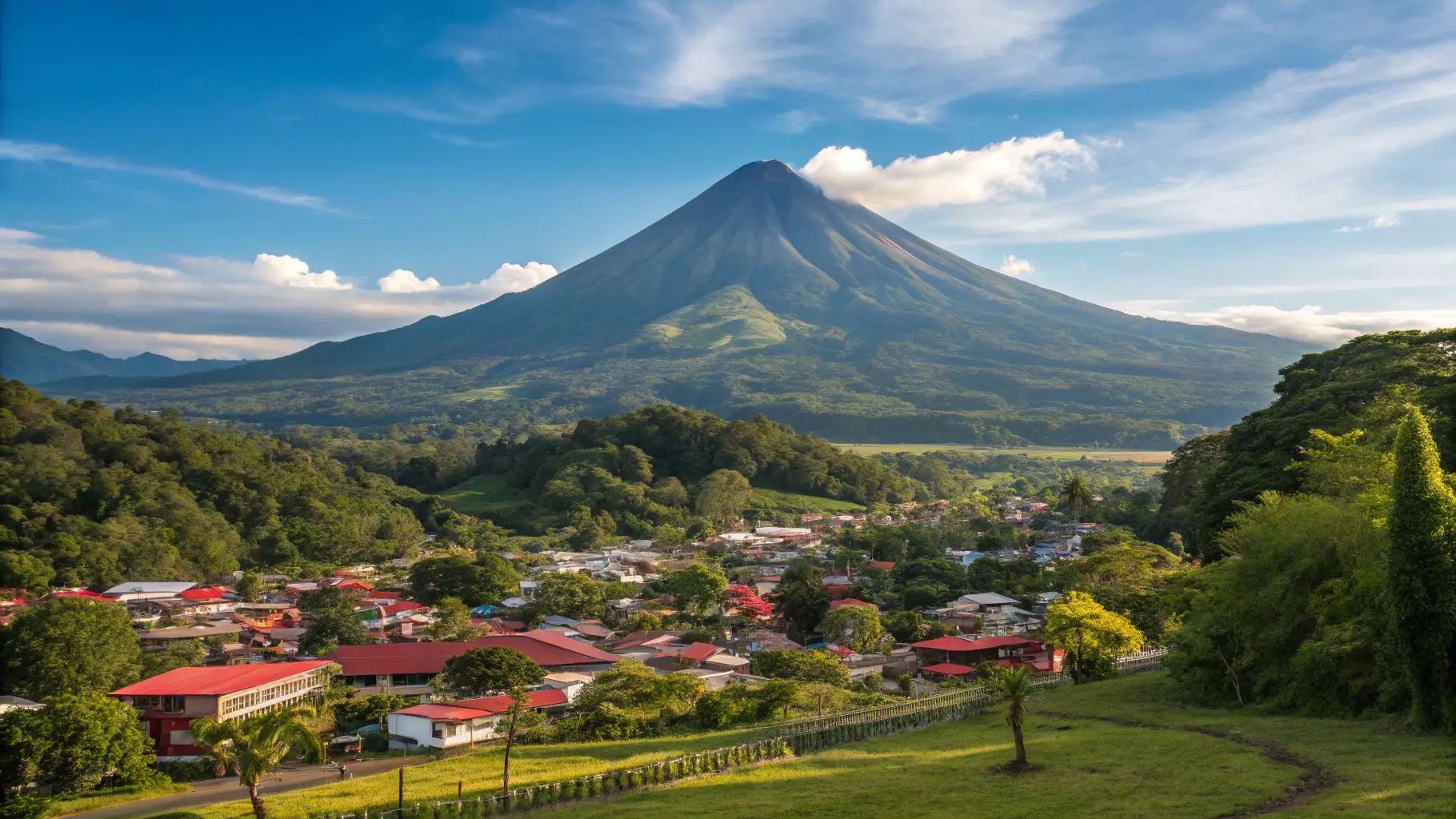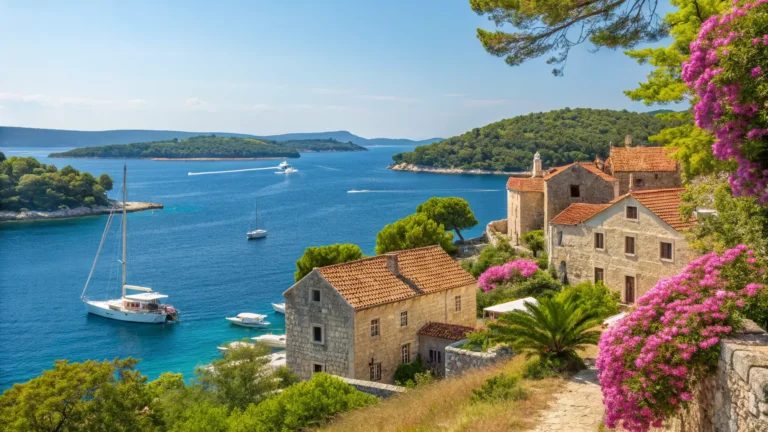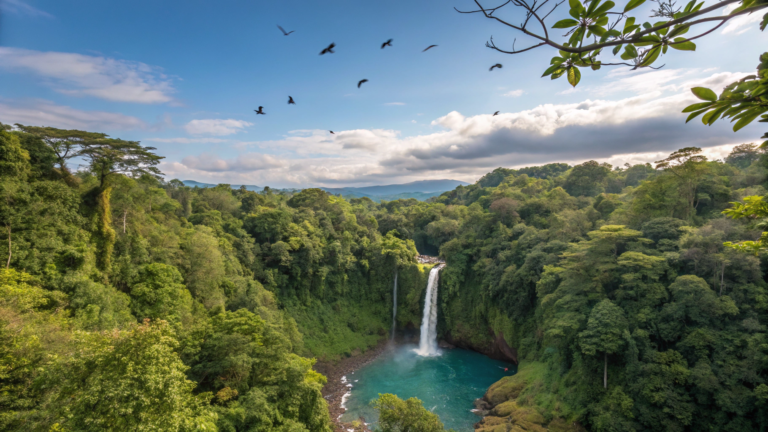5 Best Things to Do in La Fortuna Costa Rica
Last updated on May 26th, 2025 at 08:07 pm
Picture this: I’m standing in line at a gas station in San José, Costa Rica, arguing with my GPS about directions to La Fortuna. The woman behind me – probably in her sixties, wearing muddy hiking boots – overhears my struggle and starts laughing.
“First time to Arenal?” she asks in perfect English with a slight German accent.
Turns out, Greta had been visiting La Fortuna every February for eight years. She ran a small tour company back in Munich but came to Costa Rica to “remember why I fell in love with travel in the first place.” Over gas station coffee that tasted like burnt rubber, she sketched out a completely different itinerary than what I’d found online.
“Everyone does the same five things,” she said, drawing little volcanoes on a napkin. “But they do them wrong. They rush. They don’t understand what they’re actually seeing.”
That conversation completely changed my trip. Instead of following the typical tourist trail, I spent three weeks experiencing La Fortuna the way locals and repeat visitors actually do it. What I discovered was way more interesting than anything I’d read in travel guides.
Here’s what Greta taught me – and what I learned on my own – about the five experiences that’ll show you the real La Fortuna.
Arenal Volcano: The Art of Waiting
Most people think seeing Arenal Volcano is about showing up and taking pictures. Wrong. It’s about understanding weather patterns, learning to read clouds, and developing patience you didn’t know you had.
My first three days there, I saw nothing but gray mist where the volcano should’ve been. I was getting frustrated, checking weather apps constantly, wondering if this whole trip was a mistake. Then I met Roberto at a small café near the church.
Roberto had lived in La Fortuna for forty-three years. He remembered when the volcano was actively erupting, sending lava flows down its slopes and lighting up the night sky. “Tourists always ask me when they’ll see the volcano clearly,” he said, stirring sugar into his coffee. “I tell them – the volcano will show itself when it wants to. Your job is to be ready.”
He taught me something important: there’s a difference between looking and seeing.
Roberto explained that Arenal creates its own weather system. As the sun heats the slopes, warm air rises and creates clouds around the peak. Early morning, before this process starts, you get your clearest shots. Late evening, when the thermals calm down, sometimes offers another window.
But here’s what nobody mentions in the guidebooks: some of the most beautiful moments happen when the volcano is partially obscured. I got my favorite photo during a brief break in the clouds when just the upper third of the crater was visible, steam rising against dramatic storm clouds.
The Arenal Observatory Lodge sits closest to the volcano base. Twenty-two dollars gets you access to their trails and viewpoints. The lodge itself was built in 1987 as a research station for studying volcanic activity. Walking those trails, you’re literally standing on hardened lava flows from past eruptions.
The park rangers there know more about volcanic geology than most college professors. During my visit, Ranger Patricia explained how the 1968 eruption completely changed the landscape. She showed me aerial photos from before and after – it’s incredible how nature rebuilds itself.
What actually works for volcano viewing:
- Check conditions at 5:45 AM (before thermal activity starts)
- Try again around 6:30 PM (when thermals calm down)
- Don’t waste daylight hours staring at clouds
- Use cloudy volcano time for other activities
The hiking trails inside Arenal National Park wind through sections of recovered forest where you can see exactly how ecosystems regenerate after volcanic destruction. Some areas are still mostly bare rock and pioneer plants. Others have grown into dense secondary forest. It’s like watching time-lapse footage of ecological recovery.
I spent one entire morning just sitting on a lava rock from the 1968 flow, reading about the families who lost their homes and farms, and marveling at how completely nature had reclaimed most of the devastated area.
Hot Springs: More Than Just Expensive Baths
Greta’s first piece of advice was counterintuitive: “Don’t go to the famous hot springs first. Start where the locals go.”
She directed me to a place called Eco Termales, about fifteen minutes from town on a road that’s basically gravel and optimism. No fancy resort entrance, no manicured gardens – just a small sign and a parking area in the trees.
The difference was immediate. Instead of resort guests taking Instagram photos, I found Costa Rican families celebrating a grandfather’s birthday, teenagers on dates, and a group of construction workers unwinding after their shift. The pools are simple concrete circles fed by natural hot springs, surrounded by untouched forest.
Sitting in those pools, listening to families laugh and tell stories in rapid Spanish, I finally understood what “pura vida” actually means. It’s not a tourist slogan – it’s a genuine approach to enjoying life’s simple pleasures.
Tabacón Thermal Resort represents the other extreme. It’s gorgeous, no question. The landscaping looks like a movie set, with waterfalls cascading into perfectly designed pools at different temperatures. You’ll feel pampered and the mineral-rich water genuinely helps sore muscles.
But you’re paying premium prices ($120+ per person) for what’s essentially a luxury spa experience that happens to use natural hot springs. Nothing wrong with that if it’s what you want, but it’s not really Costa Rica – it’s international resort culture that could exist anywhere.
The Springs Resort became my regular spot. Eighteen pools at various temperatures, plus they’ve preserved 475 acres of primary rainforest on the property. While soaking in the upper pools, I watched keel-billed toucans feeding in the trees overhead. One evening, a three-toed sloth slowly made its way across a branch maybe twenty feet above my head.
The property includes hiking trails through their wildlife preserve, where certified naturalist guides lead early morning bird walks. I learned to identify different tanager species by their calls and spotted my first motmot bird – kind of like a kingfisher with an incredibly elaborate tail.
My honest take on hot springs:
- Start at Eco Termales for the authentic experience
- Visit The Springs for the best combination of nature and comfort
- Save Tabacón for a special occasion if luxury matters to you
- Avoid weekends at any location if you want a peaceful experience
The volcanic minerals in these waters aren’t marketing nonsense. High levels of calcium, magnesium, and sulfur compounds actually do help with muscle recovery and skin conditions. After hiking all day, an hour in 104-degree mineral water made a noticeable difference in how I felt the next morning.
Canopy Adventures: Fear and Flying
I hate heights. Always have. When Greta suggested ziplines, I literally laughed out loud.
“I didn’t come to Costa Rica to have panic attacks in the treetops,” I told her.
She just smiled. “The forest canopy is where sixty percent of rainforest life happens. You can’t understand this ecosystem from the ground.”
Peer pressure from a sixty-something German tour operator? Apparently effective.
Sky Adventures operates the longest zipline system in Costa Rica. The safety briefing took twenty-five minutes, during which I seriously considered backing out multiple times. But the guides were incredibly patient, the equipment looked professional, and everyone else seemed excited rather than terrified.
That first launch was pure panic. I’m pretty sure I made sounds that weren’t human for the first few seconds. But somewhere around the midpoint of that initial line, terror transformed into something I’d never felt before – complete freedom.
Flying through the canopy 200 feet above the ground, with Arenal Volcano rising through the clouds in the distance, wind rushing past my face… it was incredible. Not just the adrenaline rush, but the perspective. From up there, you can see how the forest layers work – emergent trees poking above the main canopy, different species occupying different vertical niches.
The tour includes fifteen separate ziplines, each offering unique views of the forest and volcano. Some are pure speed, others are slower and let you actually observe wildlife. The guides point out birds and monkeys that would be impossible to spot from ground level.
The final line ends with a controlled rappel down to a beautiful clearing where they serve fresh pineapple and explain their reforestation efforts. Sky Adventures has planted over 40,000 native trees on their property as part of connecting fragmented forest corridors.
For people who want canopy views without the speed, Mistico Hanging Bridges offers a completely different experience. Sixteen suspension bridges wind through 600 acres of protected cloud forest and rainforest. You can take your time, photograph birds, and actually learn about the ecosystem instead of just flying through it.
I met Dr. Sarah Martinez, a biology professor from UC Davis, on the hanging bridges. She’d been coming to Costa Rica for research for twelve years and knew the forest like her own backyard. She showed me things I would never have noticed – how different plants adapt to life in the canopy, why certain birds nest at specific heights, the complex relationships between species living in the same trees.
Walking those bridges with someone who understood the science behind what we were seeing made the experience incredibly rich. It wasn’t just beautiful views – it was a master class in tropical ecology.
Practical details:
- Weight limits: 80-300 pounds depending on the system
- Morning tours offer better wildlife viewing
- Wear clothes that can get muddy and closed-toe shoes
- Bring a small waterproof pouch for your camera
La Fortuna Waterfall: Earning Your Reward
Every guidebook mentions La Fortuna Waterfall, but most don’t prepare you for what’s actually involved in seeing it properly.
The trail down is 1.2 kilometers of mostly stairs – more than 500 steps descending through primary rainforest. It sounds manageable until you’re actually doing it. My knees were shaking by the time I reached the bottom, and that was the easy part.
But standing at the base of that 230-foot waterfall, surrounded by untouched rainforest, feeling the mist on your face… it’s genuinely spectacular. The sound is incredible – not just the crash of water, but the echo bouncing off the canyon walls and the subtle sounds of the forest all around you.
The swimming hole at the base stays around 70 degrees year-round. After the hike down, that cold water feels amazing. I spent over an hour just floating, looking up at this massive wall of water, feeling completely dwarfed by the power of nature.
What struck me most was how pristine everything felt. No development, no crowds (if you go early), just pure rainforest and this incredible waterfall. It’s one of those places that reminds you why Costa Rica became famous for eco-tourism in the first place.
The climb back up took me fifty-five minutes and left me completely exhausted. Those 500+ steps going uphill are no joke. I had to stop every thirty steps or so to catch my breath. But every person I passed heading down was encouraging and friendly – there’s something about shared physical challenge that brings out the best in people.
Essential waterfall information:
- Entry fee: $18 for adults, kids under 8 free
- Trail is well-maintained but very steep
- Bring water shoes for swimming and extra water for the hike
- Early morning visits (7:00-9:00 AM) mean fewer crowds
- The trail can be slippery when wet
If the challenging hike concerns you, don’t skip waterfalls entirely. Rio Celeste is about ninety minutes north and offers an easier trail to one of the most unique waterfalls in Central America. The water is an incredible turquoise color caused by volcanic minerals mixing in the river. It looks almost artificial but it’s completely natural.
I also discovered Llanos del Cortés Waterfall on my way back to San José. Much easier access (five-minute walk from the parking area) and a perfect spot for families with young kids. The wide, curtain-style waterfall creates several natural pools perfect for swimming.
Wildlife Encounters: Patience and Wonder
My most memorable wildlife encounter happened by complete accident. I was walking back to my hotel around 6:30 PM when I heard this incredible sound – like a motorcycle engine revving in the trees. I followed the noise and found myself watching a family of howler monkeys directly above the main street of La Fortuna.
These weren’t hidden-in-the-jungle animals requiring special guides to find. They were hanging out maybe forty feet above my head, completely unconcerned by the humans, cars, and daily life happening below them. The alpha male was doing his territorial call – that amazing roaring sound that can be heard from over a mile away.
I stood there for forty-five minutes, mesmerized by these wild animals living their lives in the middle of town. It was the moment I realized La Fortuna isn’t just near the rainforest – it’s part of it. The boundaries between wilderness and civilization blur here in ways I’d never experienced anywhere else.
Arenal Observatory Lodge offers guided nature walks that opened my eyes to details I would have missed completely on my own. Our guide, Carlos (a different Carlos than my gas station friend), had been leading walks for fifteen years and knew the forest better than most people know their neighborhoods.
He could identify bird calls from hundreds of yards away and spot animals that looked like brown lumps to my untrained eye. During one three-hour walk, we encountered three monkey species, two sloth species, over twenty bird species, and countless insects, including several butterfly species I’d never imagined existed.
The night tours reveal a completely different ecosystem. The forest literally transforms after dark. Sounds you never heard during daylight fill the air. Tiny frogs glow in flashlight beams. Bats with eighteen-inch wingspans glide silently overhead hunting insects.
During one night walk, we encountered a fer-de-lance – one of Central America’s most venomous snakes – coiled on a branch at eye level about five feet from the trail. Carlos calmly explained its hunting behavior while keeping our group at a safe distance. It was simultaneously terrifying and fascinating to observe this perfectly adapted predator in its natural habitat.
What you’ll realistically see with patience:
- Multiple monkey species (howlers are almost guaranteed)
- Sloths (if you have a good guide and look carefully)
- Incredible bird diversity including toucans, motmots, and tanagers
- Various reptiles from tiny geckos to large iguanas
- Butterfly species you won’t believe are real
Best viewing strategies:
- Early morning (5:30-7:30 AM) when animals are most active
- Late afternoon (4:30-6:30 PM) as diurnal animals settle down
- Night tours (7:00-9:00 PM) for completely different species
- Stay quiet and move slowly – wildlife reacts to nervous energy
The key to meaningful wildlife encounters is adjusting your expectations and developing patience. Some days you’ll see incredible things, other days just a few birds. That’s nature. But even the “quiet” days in La Fortuna’s forests are remarkable compared to most places in the world.
Timing Your La Fortuna Experience
Dry season (December through April) gives you the best chance of clear volcano views and less muddy hiking trails. But it’s also when everyone else visits. Hotels charge peak rates, popular attractions get crowded, and you’ll be sharing those perfect moments with significantly more people.
Rainy season (May through November) completely transformed my understanding of tropical travel. Yes, it rains most afternoons, but usually for just one to two hours. The rest of the time, everything is incredibly lush and green. Wildlife is more active, hotel prices drop by 30-50%, and you’ll often have major attractions almost to yourself.
I actually prefer rainy season now. There’s something magical about tropical afternoon storms – the sound of rain on forest leaves, the fresh smell in the air afterward, the way everything seems more alive. Plus, hot springs feel even better when it’s raining.
Where to stay depends entirely on what matters to you:
Nayara Gardens if you want absolute luxury and don’t mind paying for it. Tented villas with private terraces facing the volcano, butler service, and the kind of attention to detail that costs $800+ per night.
Hotel Belmar for the best balance of comfort, location, and value. Clean rooms, helpful staff, great volcano views from the restaurant, and reasonable prices even during peak season.
Selina La Fortuna for backpackers and solo travelers who want to meet other people. Social atmosphere, reliable WiFi, and organized activities if you want to join group trips.
Getting around is easier than you might expect if you plan ahead. Most tour companies provide transportation to activities, which is convenient since many attractions are 20-45 minutes from town center. If you rent a car, stick to main roads during rainy season – some secondary roads become challenging without four-wheel drive.
Why La Fortuna Matters Beyond Tourism
Sitting in those natural hot springs that final evening, watching stars appear one by one while the forest came alive with night sounds, I understood what Greta had been trying to tell me at that gas station.
La Fortuna isn’t just another tourist destination where you check activities off a list. It’s a place where you can still experience what Central America was like before mass tourism changed everything. The activities I’ve described – volcano watching, hot springs, canopy exploration, waterfall hiking, and wildlife encounters – work together to show you an ecosystem that’s been millions of years in the making.
But there’s something deeper happening here too. La Fortuna has become a model for how tourism can support conservation rather than destroy it. The money you spend on these activities directly funds forest protection, wildlife research, and local employment that provides alternatives to logging and agriculture.
Every zipline tour helps maintain forest corridors that allow wildlife to move between protected areas. Hot springs resorts protect watersheds that supply clean water to entire communities. Waterfall entrance fees fund trail maintenance and ranger salaries that keep pristine areas accessible but unspoiled.
The wildlife guides I met weren’t just showing tourists around – they were documenting species populations, monitoring habitat changes, and contributing to scientific research about tropical ecosystems. Tourism provides the economic incentive to keep these forests standing and thriving.
What I learned in La Fortuna changed how I think about travel. The best experiences can’t be rushed or guaranteed. They happen when you slow down, pay attention, and remain open to surprise. When you stop trying to collect experiences like trophies and start actually engaging with the places you visit.
These five activities aren’t just things to do – they’re ways to connect with one of the most biodiverse places on Earth, to understand why Costa Rica abolished its military in 1948 and invested that money in education and environmental protection instead, and to see what’s possible when humans choose to work with nature rather than against it.
Whether you’re someone who needs constant adventure or prefers quiet observation, whether you’re traveling solo or with family, whether this is your first international trip or your fiftieth, La Fortuna offers experiences that stick with you long after you return home.
What draws you to places like this? Is it the chance to test your limits, the opportunity to see wildlife in completely natural settings, or something else entirely? I’d love to hear about your own experiences with destinations that changed how you think about travel.








One Comment